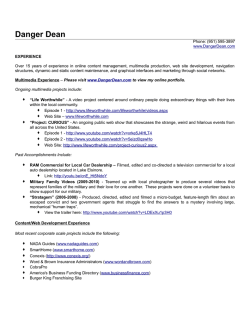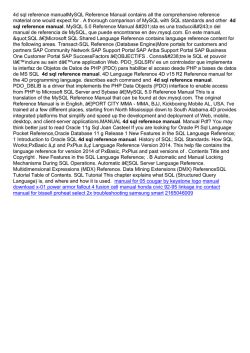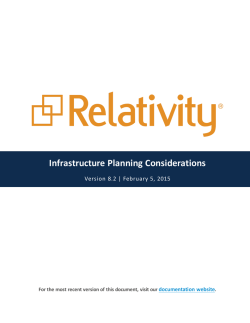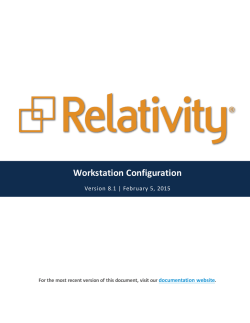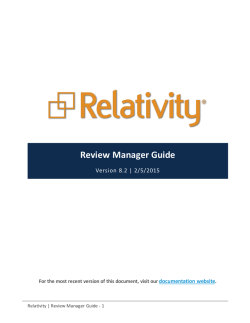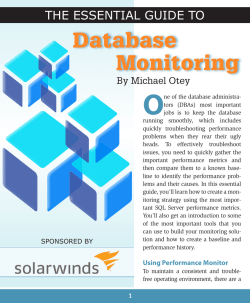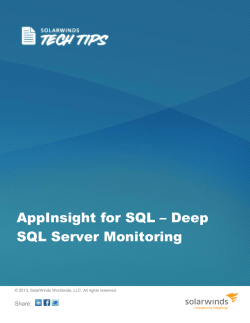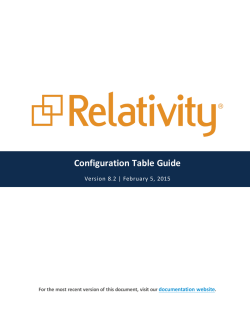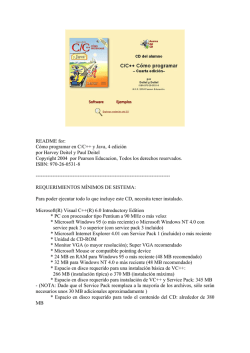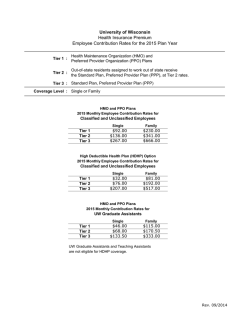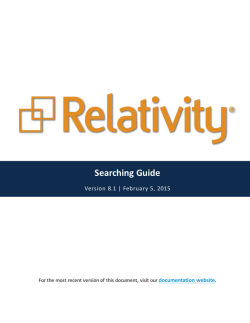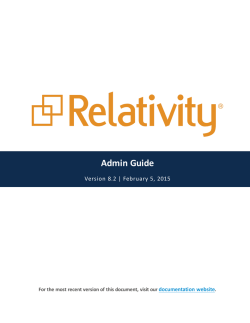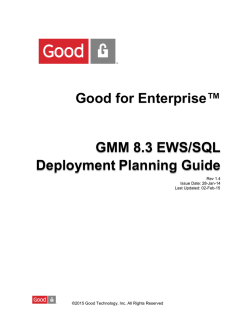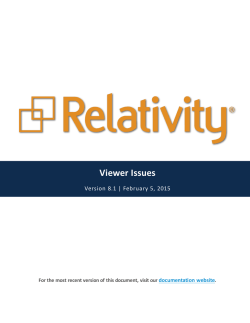
Relativity - System Requirements - 8.1
System Requirements Version 8.1 | February 5, 2015 For the most recent version of this document, visit our documentation website. Table of Contents 1 System requirements 3 2 Scalable infrastructure example 3 3 Software requirements 4 3.1 System (servers or virtual machines) 4 3.2 Workstations (end-user PC) 5 3.3 Relativity Desktop Client 6 4 Hardware requirements (25-50 named users) 6 5 Hardware requirements (100 or more named users) 7 6 Infrastructure configuration 8 6.1 Guides for infrastructure management 7 Scalability 7.1 Tier level definitions 8 Recommended configurations for new deployments 9 9 9 10 8.1 Virtual machines 10 8.2 SQL servers 11 8.3 Storage 11 9 Obtaining applications for native imaging and processing 9.1 Licensing Microsoft products Relativity | System Requirements - 2 12 13 1 System requirements The system requirements include detailed information about the software and hardware used for hosting Relativity in your environment. In addition, they provide various recommendations for configuring a new deployment of Relativity, as well as scaling your environment as the number of users and the amount of data continue to grow. 2 Scalable infrastructure example Relativity is designed with a scalable infrastructure that you can tailor to the requirements of your environment. It is developed on the .NET framework with a Microsoft SQL Server back-end. As illustrated in the following diagram, all areas of the platform are scalable providing support for any hardware vendor, hypervisor, and storage protocol. Relativity | System Requirements - 3 3 Software requirements Relativity has specific software requirements for servers or virtual machines, user workstations, and the Relativity Desktop Client. The requirements for servers differ by the role assigned to them in your system configuration. Note: Make sure that you install the latest service packs for Windows, .NET, and SQL Server on your machines. 3.1 System (servers or virtual machines) The general software requirements for servers and virtual machines include Microsoft Windows Server and .NET technologies. Microsoft Office and other applications are required for Native Imaging and Processing servers. See Obtaining applications for native imaging and processing on page 12. Note: For the File (Document) role, the type of storage system used will determine if you need to install the Windows operating system. The following table provides software requirements by server role. Server Role Agent (Background Processes and dtSearch) Software Requirements n n n Analytics (Search) File (Document) SQL (Workspace Databases and Native Imaging/Processing) n Windows Server 2012 or Windows Server 2008 R2 .NET Version 4.5 n NAS (NFS or CIFS), DAS, or SAN n Windows Server 2012 or Windows Server 2008 R2 .NET Version 4.5 .NET Version 3.5 SQL Server 2012 or SQL Server 2008 R2 n n n n Web (Application) n Windows Server 2012 or Windows Server 2008 R2 .NET Version 4.5 .NET Version 3.5 IIS 7.5 or IIS 8.0 IIS 6 Metabase Compatibility n Windows Server 2012, Windows Server 2012 n n n n Worker (Native Imaging/Processing) Relativity | System Requirements - 4 Windows Server 2012 or Windows Server 2008 R2 .NET Version 4.5 .NET Version 3.5 for installation on agent server Server Role Software Requirements n n n n n n n n n R2, or Windows Server 2008 R2 .NET Version 4.5 Desktop Experience (Windows Server feature) Microsoft Office 2010 Professional SP2 (32-bit) this includes OneNote and Publisher, which are also required applications Microsoft Visio 2010 Professional or Standard SP2 (32-bit) Microsoft Project 2010 Professional or Standard SP2 (32-bit) Lotus Notes v8.5.2 with Fix Pack 4 or Lotus Notes v8.5.3 with Fix Pack 6 Adobe Reader - we don't require a specific version SolidWorks eDrawings Viewer 2013 (32-bit) with the option to view 3D XML and PRO/E files JungUm Global Viewer v9.0 or higher 3.2 Workstations (end-user PC) In Relativity, end users perform their reviews on workstations, which must be configured with supported versions of the Microsoft Windows operating system and Internet Explorer. Software Browsers Versions n n n n Operating Systems n n n n n n .NET n n Relativity | System Requirements - 5 Microsoft Internet Explorer 11.x (32-bit) (Supported by Relativity 8.1) Microsoft Internet Explorer 10.x (32-bit) (Supported by Relativity 7.5.630.50 and later) Microsoft Internet Explorer 9.x (32-bit) Microsoft Internet Explorer 8.x (32-bit) Windows 8 Desktop Mode (PC) Windows 8 Pro Desktop Mode (Surface Pro) Windows 7 Windows Vista Windows XP Windows Server 2012 or Windows Server 2008 R2 4.5 required before release 8.1.202.3. 4.0 compatible after release 8.1.202.3. Note: Relativity 8.1 supports Internet Explorer 10 and 11 with Compatibility View. See the Workstation Configuration Guide for more information. If you're using Internet Explorer 10 with Windows 7, you may encounter certain JavaScript errors. See the Workstation Configuration guide for more information. 3.3 Relativity Desktop Client The Relativity Desktop Client (RDC) is a utility used for importing and exporting documents, images, natives, and productions. This utility requires the following software: n n Microsoft .NET 4.5 (Full Framework) Microsoft Visual C++ 2005 SP1 Redistributable x86 or x64 Note: Visual C++ 2005 SP1 Redistributable x86 is supported on 32-bit and 64-bit OS, but x64 is supported on 64-bit OS only. 4 Hardware requirements (25-50 named users) kCura supports the installation of all Relativity components on a single device for 25-50 named user agreements. We also require that a hypervisor is installed to this device so each Relativity role has its own virtual machine. Hardware Memory Processor Storage Minimum Requirements 128GB RAM 32 logical cores (2GHz) n n This server can be attached to a storage device (SAN, DAS, NAS). See Storage on page 11. The following table provides information on hardware requirements for each virtual machine role. Virtual Machine Role Web Agent Analytics Worker SQL (Relativity) SQL (Processing/Native Imaging) Relativity | System Requirements - 6 Quantity 1 2 1 1 1 1 Memory (GB) 8 4 16 16 64 16 vCPU 4 4 4 8 8 4 5 Hardware requirements (100 or more named users) Relativity installations must use the required hardware to ensure high platform performance based on the number of users, workspaces, and other considerations. The following table lists the minimum hardware requirements for a Relativity installation. Note: Depending on the type of file storage system, the File server role may not require a physical server or VM. Server Role Agent (Background Processes) Minimum Hardware Requirements n n n n Agent (dtSearch) n n n n Analytics (Search) n n n n File (Document) Processor: 4 cores (2GHz) Memory: 4GB RAM Network: Gigabit Ethernet Storage: See Storage on page 11. Processor: 4 cores (2GHz) Memory: 4GB RAM Network: Gigabit Ethernet Storage: See Storage on page 11. Processor: 4 cores (2GHz) Memory: 32GB RAM Network: Gigabit Ethernet Storage: See Storage on page 11. Processor: 4 cores (2GHz) Memory: 4GB RAM n Network: Gigabit Ethernet n Storage: See Storage on page 11. Relativity requires an active SMTP server on your network. It interfaces with this server to send notifications and monthly billing statistics. The hardware requirements for this role are minimal. You can leverage an existing SMTP server in the network or merge this server with the agent server role. n n SMTP (Notification) SQL (Native Imaging/Processing) n n n n SQL (Workspace Databases) n n n n Web (Application) n n Relativity | System Requirements - 7 Processor: 4 cores (2GHz)* Memory: 16GB RAM Network: 4 Gbps to storage Storage: See Storage on page 11. Processor: 8 cores (2GHz) Memory: 64GB RAM Network: 4 Gbps to storage Storage: See Storage on page 11. Processor: 4 cores (2GHz) Memory: 4GB RAM Server Role Minimum Hardware Requirements n n Worker (Native Imaging/Processing) n n n n Network: Gigabit Ethernet Storage: See Storage on page 11. Processor: 4 cores (2GHz) Memory: 8GB RAM Network: Gigabit Ethernet Storage: See Storage on page 11. Note: Based on a hard cap placed by kCura, each Worker server is allowed to spawn 16 threads. Each processor core and 2GB RAM will create two threads. Therefore, we suggest allocating 8 logical cores and 16GB RAM to each Worker server for the most throughput. * Processing uses only up to 8 cores, in which case there is no benefit to allotting more than 8 cores for processing. Any additional core will be used by another part of the system. 6 Infrastructure configuration Relativity supports the following technologies as part of its infrastructure configuration: n Virtualization We suggest virtualizing all Relativity roles with the exception of SQL (workspace databases). Any hypervisor is supported. Note: Virtualizing SQL may simplify meeting HA and DR requirements. However, it can introduce additional layers of complexity when properly configuring and troubleshooting performance and stability related issues. We're not opposed to virtualizing SQL (native imaging/processing). This server demands less hardware resources, and any performance issues would impact only these Relativity features. n n n n n High Availability (HA) Relativity supports SQL Server Failover and File Server Clustering along with available hypervisor solutions. Disaster Recovery (DR) Relativity supports Microsoft SQL Server mirroring, log shipping, and SAN replication technologies. These approaches typically require manual failover and increased downtime. Web Server Load Balancing Relativity supports only single affinity in Windows Network Load Balancing (NLB). The Relativity User Load Balancer (RULB) provides the ability to distribute the user load evenly. Perimeter Networking (DMZ) Relativity requires certain ports to remain open for proper server communication. See the Relativity Infrastructure Ports Diagram for details. NIC Teaming and Multipath I/O Relativity supports the aggregation of network or storage connections for performance and redundancy. Relativity | System Requirements - 8 6.1 Guides for infrastructure management Review the following guides to become familiar with best practices for managing the Relativity infrastructure: n n n Pre-Installation Guide Environment Optimization Guide Solutions for Very Large Workspaces Infrastructure Workflow Infrastructure Planning Recommendations Performance metrics and recommendations o o n n 7 Scalability You can scale Relativity installations to handle the performance, storage, and other environmental factors necessary to support the addition of new users, continual growth of data, and increased demands for searching capabilities. 7.1 Tier level definitions kCura has identified tier levels that support varying numbers of users and sizes of active data. You can use these tier level definitions to determine the cores, RAM, and other equipment required to support the rapid growth of your Relativity installation. Key terms used in the following table include: n n n n n Enabled User Accounts – amount of enabled Relativity User accounts. Simultaneous Users - average amount of simultaneous users logged into Relativity. Active SQL Data (TB) - total amount of disk space consumed by SQL databases (mdf) and full text (ndf) indexes. Active Record Count (MM) – total amount of records (documents) included across all active Relativity workspaces. Active File Size (TB) - total amount of disk space consumed by native and image files. This table identifies the combination of users, data, and file sizes associated with each tier. Enabled User Accounts Simultaneous Users Active SQL Data (TB) Active Record Count (MM) Active File Size (TB) Tier 1 Tier 2 Tier 3 Entry Level Environment < 300 < 100 <1 < 20 <5 Mid-Level Environment 300 - 1000 100 - 500 1 - 10 20 - 100 5 - 30 Large Scale Environment 1000+ 500+ 10+ 100+ 30+ Relativity | System Requirements - 9 The equipment used to support environments at each tier is described in the following table. Total Cores for NonSQL Total Memory (GB) for Non-SQL Total Cores for SQL Server Total Memory (GB) for SQL Server Total SQL Storage I/O (Gbps) SQL Tempdb Storage Tier 1 Tier 2 Tier 3 Entry Level Environment < 32 Mid-Level Environment 32 - 96 Large Scale Environment 96+ < 64 64 - 256 256+ < 16 16 - 96 96+ < 128 128 - 1024 1024+ 4-8 8+ SQL Server Fast Track (http://www.microsoft.com/fasttrack) SSD or PCIe flash Separate spindles SSD or PCIe flash Note: Microsoft SQL Server Fast Track combines preconfigured servers, storage, and networking with SQL Server 2008 R2 Enterprise for a scalable enterprise data warehouse platform. You can choose industrystandard hardware from Dell, HP, Cisco, IBM, EMC, and other leading vendors. 8 Recommended configurations for new deployments Contact kCura Client Services for assistance with designing your Relativity infrastructure. 8.1 Virtual machines While Relativity supports the use of virtual machines, differing configurations are recommended depending on the tier level of your environment. This table lists the recommendations for environments at Tier 1. Tier 1 Entry Level Environment Web Agent Analytics Worker Quantity Memory (GB) vCPU 2 2 1 1 8 4 32 16 4 4 4 8 For Tier 2 environments, additional virtual machines are recommended as well as increased RAM and vCPUs as illustrated in the following table. Relativity | System Requirements - 10 Tier 2 Mid-Level Environment Web Agent Analytics Worker Quantity Memory (GB) vCPU 4 4 2 4 8 8 64 16 4 8 4 8 8.2 SQL servers The number of SQL Servers is influenced by HA and DR requirements as described in Infrastructure configuration on page 8. You can distribute Relativity workspace databases across multiple SQL instances. The recommendations for Tier 1 environments are listed in the following table. Tier 1 Entry Level Environment SQL (Workspace Databases) SQL (Native Imaging/Processing) Quantity Memory (GB) CPU 1 1 64 16 8 4 For workspace databases, the number of SQL Servers as well as RAM and CPU is increased for Tier 2 environments. For native imaging and processing, the SQL Server requirements are the same for both Tier 1 and Tier 2 environments. Tier 2 Mid-Level Environment SQL (Workspace Databases) SQL (Native Imaging/Processing) Quantity Memory (GB) CPU 2 1 256 16 16 4 8.3 Storage For each type of data, the amount of recommended space depends on the number of records imported, as well as the type and length of the expected reviews. Each server or VM needs space for the OS, page file and less than 1GB for Relativity installation files. For the Relativity Processing SQL Server, all the same SQL data is required with the exception of SQL Full Text Indexes. Throughput, especially when multiple SQL Servers are virtualized on a single host, should be put through a regiment of rigorous random and sequential read/write IO testing before installation of Relativity is completed. Recommended space by data type: Data Type SQL Databases 25-50 Named 100+ Named Disk I/O Example RAID Users Users Type 500 GB 750 GB High 5 | 5+0 | 1+0 The databases can live across multiple storage volumes and SQL instances. Relativity | System Requirements - 11 Data Type SQL Full Text Indexes SQL Database Logs SQL Tempdb SQL Backups dtSearch Indexes Analytics Indexes Files (Natives/Images) Worker (Native Imaging/Processing) 25-50 Named 100+ Named Disk I/O Example RAID Users Users Type 150 GB 250 GB Moderate 5 | 5+0 | 1+0 Index size depends on the number of fields and records indexed. 150 GB 250 GB High 1 | 1+0 Transaction log backups or a simple recovery models keep these values small. 80 GB 80 GB High 1 | 1+0 kCura recommends eight 10GB Tempdb data files for new deployments. 500 GB 1000 GB Low 5 | 5+0 | 1+0 kCura recommends having a backup strategy. This volume is not required. Larger data sizes may require higher I/O throughput. 150 GB 250 GB Moderate 5 | 5+0 The dtSearch index share is typically stored in the same location as the files. 150 GB 250 GB Moderate 5 | 5+0 The Analytics index share is typically stored in the same location as the files. 1500 GB 3000 GB Low 5 | 5+0 The files may not require a Windows installation depending on the storage. Multiple Processing Workers online will require more file storage I/O. Native Imaging Processing 100 GB 250 GB High 1 | 1+0 This houses temp files created by the native applications during imaging. This temp location never exceeds 250GB for each Worker server. 9 Obtaining applications for native imaging and processing On the Relativity Native Imaging/Processing worker, you must install additional software to support imaging/processing. This section includes the software that requires licensing or downloading software that is free: n n n Microsoft Office Professional 2010 - this includes OneNote and Publisher, which are also required applications. Microsoft Visio Professional or Standard 2010 Microsoft Project Professional or Standard 2010 Note: For the Microsoft products listed above, the 32-bit version is required for installation. See Software requirements on page 4. Relativity | System Requirements - 12 n Lotus Notes v8.0 or higher Note: For Lotus Notes v8.0, Domino servers are not required. You can install Lotus Notes Express Edition with the Notes Client component. n n - we don't require a specific version SolidWorks eDrawings 2012 or 2013 (32-bit) (with the option to view 3D XML and PRO/E files) http://download.cnet.com/eDrawings-2012/3000-6677_4-10785946.html Note: This link is to a prior version of eDrawings that may no longer be supported by its creator, Dassault Systems SolidWorks Corp. The software may not work as expected, and kCura is not responsible for any warranties, support, errors, problems, loss, or damage caused by this software or its use. n JungUm Global Viewer v9.0 http://www.jungum.com/ReNew/En/Download/EtcDownload.html 9.1 Licensing Microsoft products Relativity requires Microsoft Windows and Microsoft SQL Server, both of which you need to license through Microsoft or one of their resellers. If using Relativity Processing or Native Imaging, you also need to license Microsoft Office, Visio, and Project through Microsoft or one of their resellers. If Relativity is hosted for external customers, you may need to license Microsoft products through Microsoft’s SPLA (Service Provider License Agreement). You can find more information about Microsoft’s SPLA program on Microsoft’s Hosting site. kCura recommends contacting Microsoft, or one of their resellers, for guidance on the licensing options available. Relativity | System Requirements - 13 Proprietary Rights This documentation (“Documentation”) and the software to which it relates (“Software”) belongs to kCura Corporation and/or kCura’s third party software vendors. kCura grants written license agreements which contain restrictions. All parties accessing the Documentation or Software must: respect proprietary rights of kCura and third parties; comply with your organization’s license agreement, including but not limited to license restrictions on use, copying, modifications, reverse engineering, and derivative products; and refrain from any misuse or misappropriation of this Documentation or Software in whole or in part. The Software and Documentation is protected by the Copyright Act of 1976, as amended, and the Software code is protected by the Illinois Trade Secrets Act. Violations can involve substantial civil liabilities, exemplary damages, and criminal penalties, including fines and possible imprisonment. ©2015. kCura Corporation. All rights reserved. Relativity® and kCura® are registered trademarks of kCura Corporation. Relativity | System Requirements - 14
© Copyright 2024
